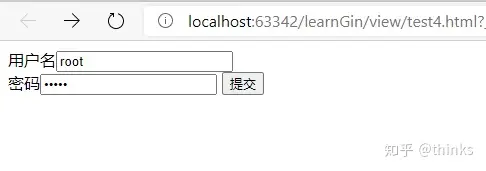gin 数据解析和绑定
1 Json 数据解析和绑定
- 客户端传参,后端接收并解析到结构体
package main
import (
"fmt"
"github.com/gin-gonic/gin"
"net/http"
)
//定义接收数据的结构体
type Login struct {
//binding:"required"修饰的字段,若接收为空值,则报错,是必须字段
User string `form:"username" json:"user" uri:"user" xml:"user" binding:"required"`
Pssword string `form:"password" json:"password" uri:"password" xml:"password" binding:"required"`
}
func main() {
// 1.创建路由
// 默认使用了2个中间件Logger(), Recovery()
r := gin.Default()
//Json绑定
r.POST("loginJson", func(c *gin.Context) {
//声明接收的变量
var json Login
// 将request的body中的数据,自动按照json格式解析到结构体
if err := c.ShouldBindJSON(&json); err != nil {
// 返回错误信息
// gin.H封装了生成json数据的工具
c.JSON(http.StatusBadRequest, gin.H{"error": err.Error()})
return
}
//判断用户名密码是否正确
if json.User != "root" || json.Pssword != "admin" {
c.JSON(http.StatusBadRequest, gin.H{"status": "304"})
return
}
fmt.Println(json)
c.JSON(http.StatusOK, gin.H{"status": 200})
})
r.Run(":8080")
}
使用cmd,分别输入以下内容:
curl http://127.0.0.1:8080/loginJson -H "Content-Type: application/json" -d {"user":"root","password","admin"} -X POST
curl http://127.0.0.1:8080/loginJson -H "Content-Type: application/json" -d "{\"user\":\"root1\",\"password\":\"admin\"}" -X POST
curl http://127.0.0.1:8080/loginJson -H "Content-Type: application/json" -d "{\"user\":\"root\",\"password\":\"admin\"}" -X POST
正确输出:
{"error":"invalid character 'u' looking for beginning of object key string"}
{"status":"304"}
{"status":200}2 表单数据解析和绑定
<!DOCTYPE html>
<html lang="en">
<head>
<meta charset="UTF-8">
<meta name="viewport" content="width=device-width, initial-scale=1.0">
<meta http-equiv="X-UA-Compatible" content="ie=edge">
<title>Document</title>
</head>
<body>
<form action="http://localhost:8080/loginForm" method="post" enctype="application/x-www-form-urlencoded">
用户名<input type="text" name="username"><br>
密码<input type="password" name="password">
<input type="submit" value="提交">
</form>
</body>
</html>
//定义接收数据的结构体
type Login struct {
//binding:"required"修饰的字段,若接收为空值,则报错,是必须字段
User string `form:"username" json:"user" uri:"user" xml:"user" binding:"required"`
Pssword string `form:"password" json:"password" uri:"password" xml:"password" binding:"required"`
}
func main() {
// 1.创建路由
// 默认使用了2个中间件Logger(), Recovery()
r := gin.Default()
// JSON绑定
r.POST("/loginForm", func(c *gin.Context) {
// 声明接收的变量
var form Login
// Bind()默认解析并绑定form格式
// 根据请求头中content-type自动推断
if err := c.Bind(&form); err != nil {
c.JSON(http.StatusBadRequest, gin.H{"error": err.Error()})
return
}
// 判断用户名密码是否正确
if form.User != "root" || form.Pssword != "admin" {
c.JSON(http.StatusBadRequest, gin.H{"status": "304"})
return
}
c.JSON(http.StatusOK, gin.H{"status": "200"})
})
r.Run(":8080")
}

3 URI数据解析和绑定
// 定义接收数据的结构体
type Login struct {
// binding:"required"修饰的字段,若接收为空值,则报错,是必须字段
User string `form:"username" json:"user" uri:"user" xml:"user" binding:"required"`
Pssword string `form:"password" json:"password" uri:"password" xml:"password" binding:"required"`
}
func main() {
// 1.创建路由
// 默认使用了2个中间件Logger(), Recovery()
r := gin.Default()
// JSON绑定
r.GET("/:user/:password", func(c *gin.Context) {
// 声明接收的变量
var login Login
// Bind()默认解析并绑定form格式
// 根据请求头中content-type自动推断
if err := c.ShouldBindUri(&login); err != nil {
c.JSON(http.StatusBadRequest, gin.H{"error": err.Error()})
return
}
// 判断用户名密码是否正确
if login.User != "root" || login.Pssword != "admin" {
c.JSON(http.StatusBadRequest, gin.H{"status": "304"})
return
}
c.JSON(http.StatusOK, gin.H{"status": "200"})
})
r.Run(":8000")
}
在CMD输入:
curl http://127.0.0.1:8000/root/admin
{"status":"200"} 粤公网安备 44200002444923号
粤公网安备 44200002444923号